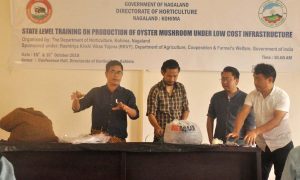Published on Oct 15, 2018
By EMN
Share
 Resource persons demonstrate to trainees the methods involved in cultivating oyster mushrooms, at the directorate of Horticulture, on Oct. 15.[/caption]
Dimapur, Oct. 15 (EMN): A training program that would teach oyster mushroom production commenced on October 15 at the directorate of Horticulture, in Kohima. The program was organised by the Horticulture department.
Updates on Monday informed that an assistant horticulture officer, T Eluba, gave highlights about mushroom production. There are 2,300 species and 200 ‘genres’ of mushroom. Out of 2300 species, 12 species are edible and can be grown and cultivated, the gathering was told. He said ‘mushroom technology’ reached India in the 60s and by the mid-70s cultivation started. The ‘mushroom technology’ reached Nagaland during the ‘90s but ‘till now commercialization has not materialised because lots of money is required to take up this technology,’ the gathering was told.
Deputy director of the Horticulture department, Meyasashi, gave a power presentation on the methods used in oyster mushroom cultivation; methods of post-harvesting handling; general preventive measure against mushroom diseases and pests; and recycling spent mushroom substrate into organic manure, among others. Mushroom can be cultivated from a tree or plant that has elasticity, he said, such as saw dust, corn leaves, dry banana leaves, paddy straw, and soya bean leaves, he told the gathering. He said that mushroom was one of the fastest growing organisms in the world and an excellent source of high quality protein; it is low in cholesterol, and is a good source of selenium, dietary fibre, potassium, vitamin B1, B2 &D, low calories, fat and sodium, anti-oxidants to support immune system, among others.
On the first day of the event, people from Peren, Kohima, Dimapur, Mokokchung, and Tseminyu in Kohima; and Wokha were trained. People from other districts will be trained on October 16, the updates stated.
Resource persons demonstrate to trainees the methods involved in cultivating oyster mushrooms, at the directorate of Horticulture, on Oct. 15.[/caption]
Dimapur, Oct. 15 (EMN): A training program that would teach oyster mushroom production commenced on October 15 at the directorate of Horticulture, in Kohima. The program was organised by the Horticulture department.
Updates on Monday informed that an assistant horticulture officer, T Eluba, gave highlights about mushroom production. There are 2,300 species and 200 ‘genres’ of mushroom. Out of 2300 species, 12 species are edible and can be grown and cultivated, the gathering was told. He said ‘mushroom technology’ reached India in the 60s and by the mid-70s cultivation started. The ‘mushroom technology’ reached Nagaland during the ‘90s but ‘till now commercialization has not materialised because lots of money is required to take up this technology,’ the gathering was told.
Deputy director of the Horticulture department, Meyasashi, gave a power presentation on the methods used in oyster mushroom cultivation; methods of post-harvesting handling; general preventive measure against mushroom diseases and pests; and recycling spent mushroom substrate into organic manure, among others. Mushroom can be cultivated from a tree or plant that has elasticity, he said, such as saw dust, corn leaves, dry banana leaves, paddy straw, and soya bean leaves, he told the gathering. He said that mushroom was one of the fastest growing organisms in the world and an excellent source of high quality protein; it is low in cholesterol, and is a good source of selenium, dietary fibre, potassium, vitamin B1, B2 &D, low calories, fat and sodium, anti-oxidants to support immune system, among others.
On the first day of the event, people from Peren, Kohima, Dimapur, Mokokchung, and Tseminyu in Kohima; and Wokha were trained. People from other districts will be trained on October 16, the updates stated.